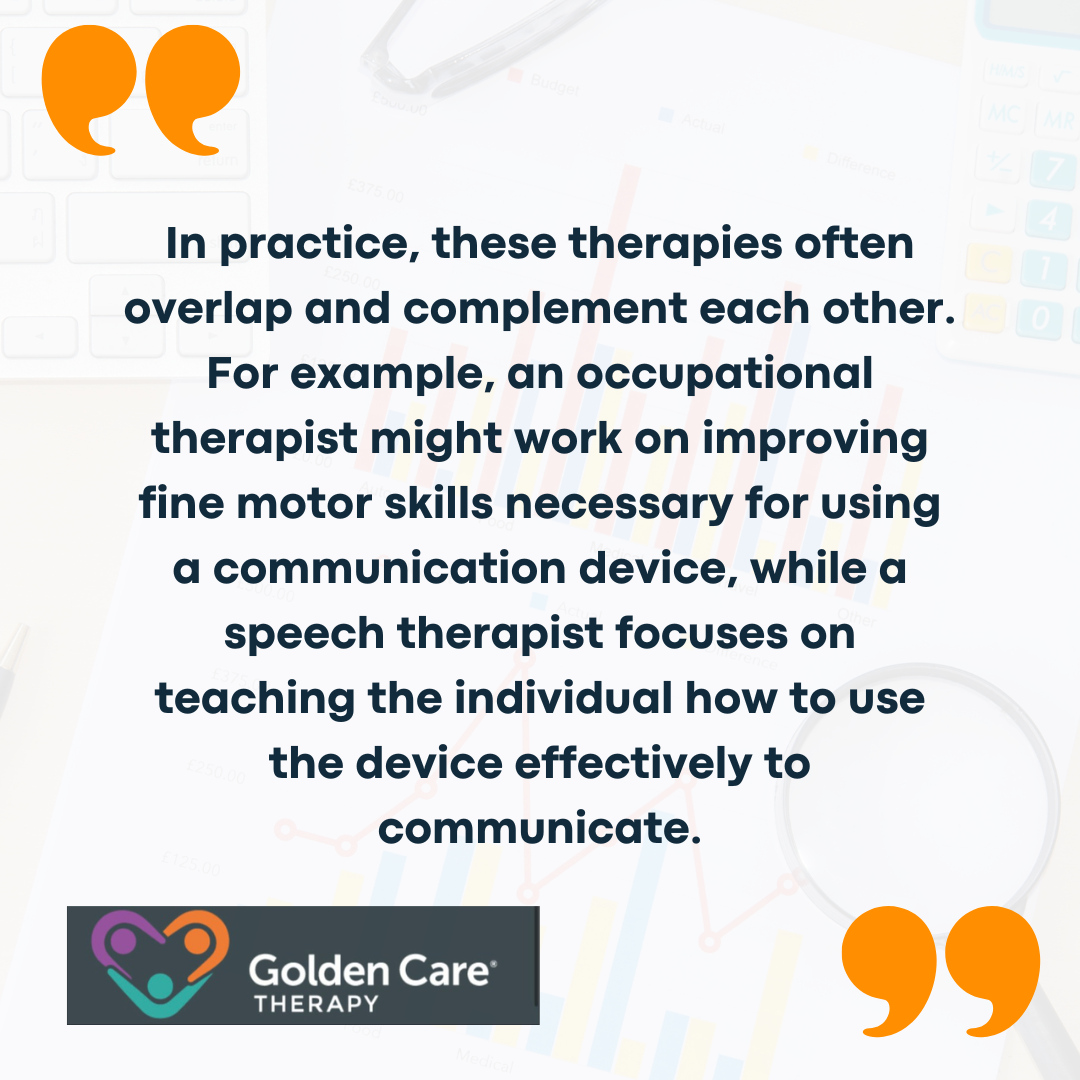Autism spectrum disorder presents a unique array of challenges that affect various aspects of an individual’s life. Among these challenges are difficulties with communication, social interaction, and sensory processing.
To support individuals with autism in overcoming these hurdles, various therapeutic interventions are employed.
Two of the most prominent and effective therapies are occupational therapy (OT) and speech therapy (ST). While both play crucial roles in the development and well-being of individuals with autism, they focus on different aspects of functioning and development. Let’s find out what those are.

What is Occupational Therapy
Occupational therapy aims to help individuals achieve independence in all areas of their lives. For children and adults with autism, OT focuses on enhancing their ability to perform daily activities, improve their social skills, and regulate their sensory experiences. This therapy is holistic, considering the physical, emotional, and social needs of the individual.
OT practitioners assess and address a range of skills and behaviors, including fine and gross motor skills, play and leisure activities, self-care routines, sensory processing issues, and even mental health issues.
Fine motor skills involve small movements, such as using utensils, writing, or buttoning clothes, while gross motor skills involve larger movements, such as walking, jumping, or climbing.
The Role of Occupational Therapy in Autism
Occupational therapists work with individuals with autism to develop personalized intervention plans tailored to their unique needs and goals. These plans may include activities designed to improve coordination, strength, and sensory processing.
For example, a child struggling with sensory sensitivities may engage in sensory integration therapy, which involves activities that help them manage and respond appropriately to sensory input.
One of the critical aspects of OT in autism is the development of social skills. Therapists use play-based activities to teach children how to interact with peers, understand social cues, and build meaningful relationships. These activities are often structured to mimic real-life scenarios, providing a safe environment for practice and learning.
Sensory Integration and Occupational Therapy
Sensory integration is a significant component of OT for individuals with autism. Many people with autism experience sensory processing disorders, where they might be overly sensitive (hypersensitive) or under-responsive (hyposensitive) to sensory stimuli. This can manifest in various ways, such as being overwhelmed by loud noises, avoiding certain textures, or seeking intense sensory experiences like spinning or jumping.
Occupational therapists use sensory integration techniques to help individuals regulate their sensory experiences. This might include activities like swinging, bouncing on a therapy ball, or tactile play with different textures.
The goal is to help the individual achieve a balanced sensory state, improving their ability to participate in daily activities and reducing sensory-related stress and anxiety.

What is Speech Therapy
On the other hand, speech therapy, also known as speech-language pathology (SLP), focuses on improving communication skills. For individuals with autism, speech therapy addresses both verbal and non-verbal communication challenges. This includes not only the ability to speak clearly and fluently but also the understanding and use of language, social communication skills, and alternative communication methods.
Speech therapists work on a variety of communication skills, including articulation, language development, social pragmatics, and the use of augmentative and alternative communication (AAC) devices.
These devices can range from simple picture boards to advanced speech-generating devices, depending on the individual’s needs.
The Role of Speech Therapy in Autism
For many individuals with autism, communication is a primary area of concern. Speech therapists assess each individual’s communication abilities and create tailored intervention plans. These plans might involve exercises to improve speech articulation, strategies to enhance language comprehension and expression, and techniques to develop social communication skills.
One crucial aspect of speech therapy in autism is the focus on social pragmatics. This involves teaching individuals how to use language appropriately in social contexts, such as taking turns in conversation, understanding body language and facial expressions, and responding to social cues.
Social stories and role-playing are common techniques used to teach these skills.

Augmentative and Alternative Communication (AAC)
AAC is an essential component of speech therapy for individuals with autism who have significant speech and language challenges. AAC includes any form of communication that supplements or replaces spoken language. This can be particularly beneficial for non-verbal individuals or those with limited verbal skills.
Speech therapists work with individuals and their families to identify the most suitable AAC methods. This might include picture exchange systems, communication boards, or electronic devices that generate speech.
The goal is to provide individuals with effective tools to communicate their needs, thoughts, and feelings, thereby enhancing their independence and quality of life.
Differences Between Occupational Therapy and Speech Therapy
While both OT and ST are vital for individuals with autism, they address different areas of development and functioning. OT focuses on improving daily living skills, sensory processing, and social interactions, while ST concentrates on enhancing communication abilities, including speech, language, and social pragmatics.

This interdisciplinary approach ensures that all aspects of the individual’s needs are addressed in a cohesive and comprehensive manner.
Early intervention is crucial for children with autism. Research has shown that the earlier children receive therapeutic interventions, the better their outcomes in terms of communication, social skills, and overall development. Both OT and ST play a significant role in early intervention programs, helping young children develop essential skills during critical developmental periods.
For instance, early speech therapy can help young children develop foundational language skills, such as understanding and using basic words and phrases. Early occupational therapy can support the development of motor skills and sensory regulation, which are essential for participation in daily activities and social interactions.
Integrating Occupational Therapy and Speech Therapy
To illustrate the integration of occupational therapy and speech therapy, consider the case of a young child with autism who has difficulty with both sensory processing and communication. The child may become overwhelmed by sensory input, leading to meltdowns and withdrawal from social interactions. Additionally, the child may have limited verbal skills and struggle to communicate needs and emotions.
An occupational therapist might start by working on sensory integration techniques to help the child manage sensory input more effectively. This could involve activities like brushing therapy, deep pressure therapy, or sensory play with different textures.
As the child’s sensory regulation improves, they may become more comfortable and open to engaging in social interactions.
Simultaneously, a speech therapist would work on developing the child’s communication skills. This might involve using picture exchange systems to help the child express their needs and gradually introducing more complex communication methods as the child’s skills develop. The speech therapist would also work on social communication skills, teaching the child how to interact with peers and adults in various contexts.
By addressing both sensory processing and communication challenges, the combined efforts of the occupational and speech therapists help the child make significant progress. The child becomes more comfortable in different sensory environments and more capable of expressing their needs and engaging in social interactions, leading to improved overall functioning and quality of life.
The collaborative approach involving both therapies ensures that individuals with autism receive holistic and effective interventions tailored to their unique needs. Early intervention, family involvement, and interdisciplinary collaboration are key factors in achieving the best outcomes for individuals with autism.
Integrating the strengths of both occupational and speech therapy allows autistic individuals to develop the skills they need to lead more independent, fulfilling lives. If you are looking for specialized support, consider exploring ABA programs in NJ, Indiana, Georgia, and New York. Golden Care Therapy offers comprehensive services tailored to meet the unique needs of each individual. Contact us todayor book an appointment to learn more about how we can help.
Sources:
https://www.therapyplacenj.com/speech-therapy-and-occupational-therapy



